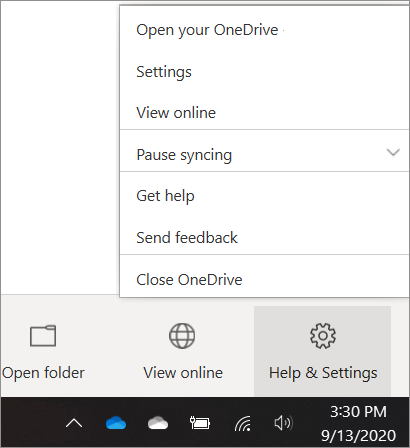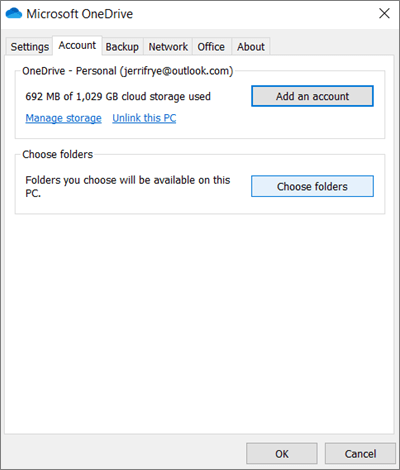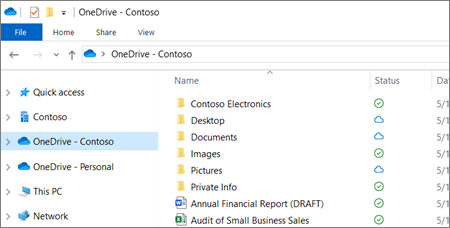If you're a small business owner or are using OneDrive for business-related needs, you'll need to make sure to store your files to OneDrive for work or school. With OneDrive for work or school, you get the same anywhere access and file protection you get with OneDrive, plus business-specific features like data encryption, advanced data-loss protection, and more control and permission-setting for files.
This article describes how to move files you're storing in Microsoft OneDrive or other cloud-based file storage services to OneDrive for work or school in Microsoft 365. Part of a larger organization? Learn more about enterprise solutions.
Note: OneDrive for work or school can be purchased as its own subscription, or it can be found as part of a Microsoft 365 subscription. With Microsoft 365, you'll get additional benefits including premium versions of apps like Word, Excel, and PowerPoint, SharePoint, along with Microsoft Teams for communication and collaboration. Learn more about Microsoft 365 for business.
Start here
If you are migrating data from other cloud service providers into OneDrive or SharePoint, Mover supports migration from over a dozen cloud service providers, including Box, Dropbox, Egnyte, and Google Drive. Mover can also be used to migrate from one SharePoint tenant to another, or from OneDrive consumer or OneDrive.com. Learn more about Mover.
If you have local access to your OneDrive files, you can move files to OneDrive for work or school simply by uploading them in a web browser. However, for efficiency, we recommend using the OneDrive sync app. The table below summarizes the tasks and considerations related to moving files to OneDrive for work or school.
-
Sync OneDrive for work or school to your computer - This gives you a connection to OneDrive for work or school on your local computer.
-
Move your OneDrive files - All files you place in your synced OneDrive for work or school folder automatically upload to the cloud whenever you're online.
-
Move a OneNote notebook to OneDrive - You'll need to use different steps to move your OneNote notebooks.
-
Share files in OneDrive for work or school - You may have shared files with other people in OneDrive. When you move these files to OneDrive for work or school, these are recognized as new files. Therefore, you may want to share some of these files again.
-
Cancel your OneDrive personal subscription, if needed - After you've moved your business files to OneDrive for work or school, you can either continue using OneDrive for personal use or cancel your OneDrive personal subscription. If you choose not to cancel the subscription, your subscription will be auto-renewed.
Sync OneDrive for work or school to your computer
When you sync your files with the sync app, you can move your OneDrive files around just like other files on your computer. It's easier and quicker, because you aren't dependent on a network. Note the following important details about using the sync app for this task:
-
You can't use the sync app to move OneNote notebooks. For information on moving OneNote notebooks, see Move OneNote notebooks to OneDrive.
-
If you want to move more than 300,000 items to OneDrive for work or school, you won't be able to use the sync app to move your files. For more information and guidance, see I want to move more than 300,000 items to OneDrive work or school.
Follow the steps below to set up your sync connection with OneDrive for work or school. If you've already set this up, you can skip to the next section.
-
Sign in to Microsoft 365.
-
Select the white or blue OneDrive cloud icon in the Windows taskbar notification area.

-
Select
 Help & Settings > Settings.
Help & Settings > Settings.
(You might need to click the Show hidden icons arrow next to the notification area to see the OneDrive icon. If the icon doesn't appear in the notification area, OneDrive might not be running. Click Start, type OneDrive in the search box, and then click OneDrive in the search results.)
-
In Settings, select Account, and then select Add an account.

-
When OneDrive Setup starts, enter your new account, and then select Sign in.

Move OneDrive files to your synced OneDrive for work or school folder
To move your OneDrive files to OneDrive for work or school, drag them from your synced OneDrive folder to your synced OneDrive for work or school folder.
Note: Before moving your files from OneDrive to OneDrive for work or school, you may want to consider using Files On-Demand. For more information, see Learn about OneDrive Files On-Demand.
-
In File Explorer, open your synced OneDrive folder.
By default, your synced OneDrive folder is located in c:\users\username\OneDrive. It should also appear under your favorites.

-
Drag the files you want to your synced OneDrive for work or schoolfolder.
Important: If you're moving a large number of files, for best results, we strongly recommend that you move files in batches of no more than 100 files each.
Once you've moved files to the synced library folder, they're automatically uploaded to OneDrive for work or school on Microsoft 365. For information about the various icons related to a file's status, refer to What do the OneDrive icons mean?
Notes about moving files from OneDrive to OneDrive for work or school
Note the following details about moving files from OneDrive to OneDrive for work or school:
-
Files you move from OneDrive to OneDrive for work or school are essentially recognized as new files, and as a result, these files don't retain metadata details such as Modified and Modified By.
-
OneDrive for work or school restricts certain file types. For more information, refer to Types of files that cannot be added to a list or library.
Share files in OneDrive for work or school
If you shared files in OneDrive, you'll need to share these files again in OneDrive for Business after you move them. Also, once you share the files you move into OneDrive for work or school, we recommend that you delete the original files from OneDrive. This way, people won't be able to refer to out-of-date copies of files you'd shared with them earlier.
Cancel your OneDrive personal subscription, if needed
For info on how to cancel your subscription, see OneDrive storage plan and billing questions. Under What do you want to know? select I want to uninstall or cancel OneDrive.
I want to move more than 300,000 items to OneDrive for work or school
If you want to move more than 300,000 items to OneDrive for work or school, we recommend the following steps:
-
Move as many items as possible using the sync app as described in this article.
Upload files in batches of no more than 100 items at a time.
Note: Items consist of files and folders.
-
When you start to approach the 300,000 mark, Stop syncing with the OneDrive for work or school app.
-
Upload all remaining files to OneDrive for work or school in a web browser using the Upload command.
Note: If you are concerned about file storage space, you might want to enable Files On-Demand. For more information, see Learn about OneDrive Files On-Demand.
Thanks for more information in OneDrive For Business:OneDrive Migration Solutions
ReplyDelete